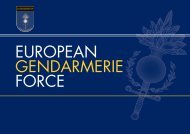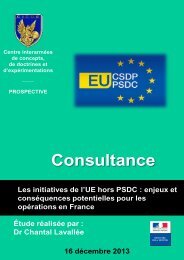Conference
science-research-bulletin-2013-conference
science-research-bulletin-2013-conference
Create successful ePaper yourself
Turn your PDF publications into a flip-book with our unique Google optimized e-Paper software.
EUROPEAN POLICE SCIENCE AND RESEARCH BULLETIN<br />
SPECIAL CONFERENCE EDITION<br />
Member States have often been regulated at the<br />
supranational level. Compared to international<br />
cooperation, EU strategies are more far-reaching<br />
and go beyond international sovereignty<br />
concerns. This contribution presents both the EU<br />
and the Australian system of police cooperation<br />
in comparative socio-legal perspective and<br />
highlights some of the reasons why lawenforcement<br />
cooperation in the EU might, to<br />
some extent, be considered more advanced.<br />
II. COOPERATION STRATEGIES IN<br />
THE EU<br />
The development of police cooperation in the<br />
EU in the last 20 years is impressive, not only<br />
considering that many of its current members<br />
were in a state of war less than 70 years ago<br />
(Dedman, 1996, pp. 10-11; Pinder & Usherwood,<br />
2007, pp. 1-3), but also in comparison to<br />
cooperation within federal systems, such as<br />
Australia. The study this article is based upon has<br />
concluded that many cooperation strategies, like<br />
access to data such as criminal records, has in<br />
some federal systems not been developed much<br />
earlier than in the EU between sovereign nation<br />
states. This is particularly remarkable considering<br />
that police and criminal justice cooperation and a<br />
common security policy were not even envisaged<br />
when the European Economic Community (EEC)<br />
was established in 1957 (Preamble to Treaty<br />
Establishing the European Economic Community;<br />
Pinder & Usherwood, 2007, pp. 3-6). The EU was<br />
formed mainly to prevent future wars among the<br />
Member States by including them in one entity<br />
with common interests and goals (Ibid; Craig<br />
& de Búrca, 2011, p. 7). Economic cooperation<br />
aimed at establishing an internal market within<br />
the EEC then culminated in the Single European<br />
Act in 1986, with Article 8A providing for the<br />
abolition of border-controls between Member<br />
States (Single European Act). The Treaty on<br />
European Union, which was signed in 1992, was<br />
the first to integrate law enforcement between<br />
the Member States (Treaty on European Union). In<br />
its Title VI on Co-operation in the Field of Justice<br />
and Home Affairs, which was a significant step<br />
towards a harmonised EU framework on police<br />
cooperation, it provides for this integration (Den<br />
Boer, 1996, p. 247; Fijnaut, 2004, pp. 241-242).<br />
Article 29 of the TEU prescribed that citizens<br />
should be provided with a high level of safety<br />
within an area of freedom, security and justice by<br />
preventing and combating crime through closer<br />
cooperation between police forces, customs<br />
authorities and other competent authorities in<br />
the Member States.<br />
Existing police cooperation strategies between<br />
EU Member States today go far beyond the<br />
founding aims of creating peace, economic<br />
prosperity and stability in the EEC. Advanced<br />
bilateral and multilateral cooperation initiatives<br />
have developed and require the partial surrender<br />
of sovereignty rights in order to facilitate the<br />
exercise of powers of law enforcement on<br />
foreign territory (See, in relation to the Belgium,<br />
German, Dutch Cooperation in the common<br />
border region: Spapens, 2008, pp. 225-226;<br />
and more generally: Sheptycki, 1996, p. 10).<br />
This development is particularly remarkable<br />
as policing is one of the most ‘sovereignty<br />
sensitive’ functions of a nation state (Wallace,<br />
1999, pp. 509-510). Furthermore, cooperation<br />
strategies were developed despite the existence<br />
of divergent cultures, structures, languages and<br />
histories of police organisations in the Member<br />
States (Hebenton and Thomas, 1995, pp. 24-37).<br />
Police cooperation has increasingly become a<br />
focus of European attention since the 1970s and<br />
the onset of the threat of terrorism in Europe<br />
(Busch, 1995, pp. 285-292). This led to the<br />
development of a number of intergovernmental<br />
initiatives (which are comparable to Australian<br />
cooperative federalism). Three ways of promoting<br />
police cooperation developed in the EU and<br />
are therefore the focus of this comparison. The<br />
first are ‘legal’ strategies, such as supranational<br />
legal frameworks and the harmonisation of<br />
criminal law and procedure. The second are<br />
‘compensatory’ strategies, created to counteract<br />
or compensate for the current lack of legal<br />
regulation and harmonisation in this field and<br />
to overcome cultural and structural differences<br />
of the organisations involved. ‘Compensatory’<br />
strategies in this context are common education<br />
and training, common forums and common<br />
institutions or agencies. The third are advanced<br />
‘regional’ cooperation strategies, encompassing<br />
the previous two strategies but developing them<br />
further in the regional context.<br />
What can already be stated with a view to Australian<br />
strategies is that legal strategies are nearly nonexistent.<br />
Australia relies on the existence of its<br />
federal police more than on legal frameworks and<br />
harmonisation facilitating cooperation between<br />
its states and territories. However, Australia also<br />
115





